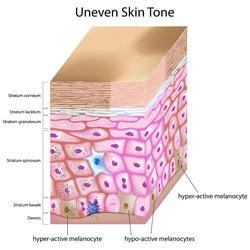Dealing With Irregular Skin Pigmentation
posted: Mar. 19, 2019.
 Brown spots and skin discoloration are frequent complaints for many people. The most common form of irregular pigmentation is hyperpigmentation, a condition in which patches of skin become darker in color than the normal surrounding skin. Some people have abnormal skin pigmentation from a young age, and for others it is brought on later in life by sun damage or injury to the skin. Individuals of all ages, ethnicities and skin types can be affected, although those with darker skin tones are more prone to develop it.
Brown spots and skin discoloration are frequent complaints for many people. The most common form of irregular pigmentation is hyperpigmentation, a condition in which patches of skin become darker in color than the normal surrounding skin. Some people have abnormal skin pigmentation from a young age, and for others it is brought on later in life by sun damage or injury to the skin. Individuals of all ages, ethnicities and skin types can be affected, although those with darker skin tones are more prone to develop it.
Hyperpigmentation usually appears as brown spots and dark patches on the face, chest, arms and hands. This darkening occurs when an excess of melanin, the brown pigment that produces normal skin color, forms deposits in the skin. Sun exposure, acne, genetics and hormonal changes can trigger or worsen irregular pigmentation.
Not all pigmentation problems can be avoided, but you can follow preventive measures to control and reduce dark spots from forming. It is especially important to use adequate sunscreen, manage your acne and discontinue the use of any oral medications that may be contributing to the problem.
How Can I Combat Hyperpigmentation?
The good news is that skin hyperpigmentation isn’t dangerous, and proper treatment can help rejuvenate troubling patches on the skin. There are many treatments at your dermatologist’s disposal, ranging from topical creams and dermabrasion to chemical peels and laser procedures. Your dermatologist will work with you to determine the most suitable treatment for your particular skin type and problem.
Although a frustrating condition, your skin complexion can be improved and corrected. Talk to your dermatologist about the best treatment options for you.

